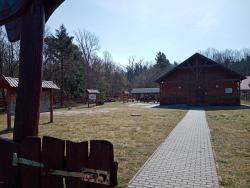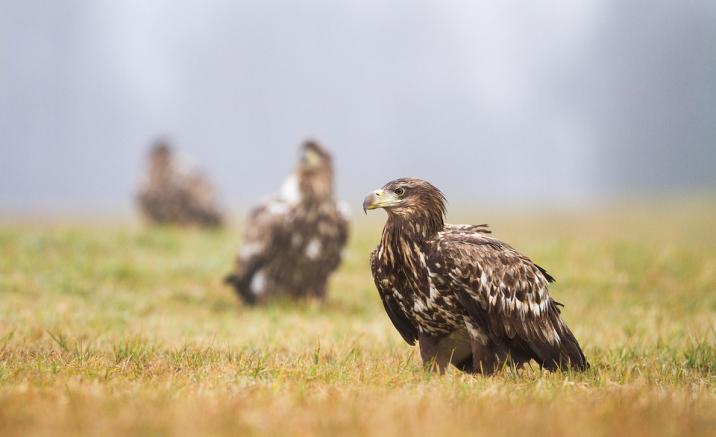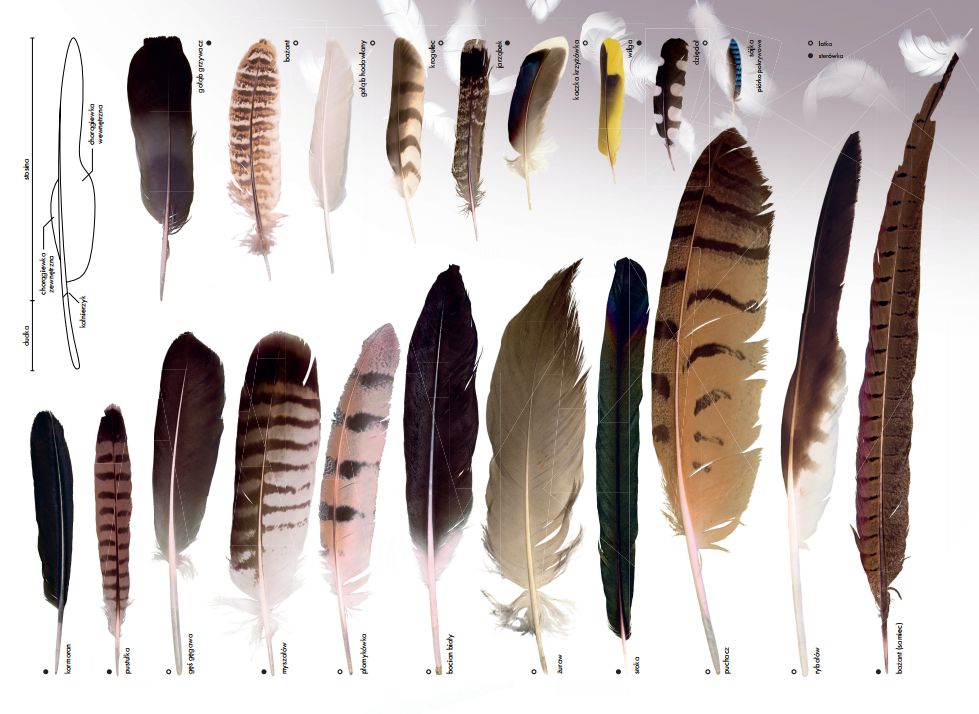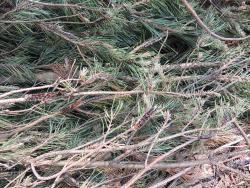 Asset Publisher
Asset Publisher
U nas mają swój bezpieczny dom
Ich wielkie pióra znajdujemy czasem w lesie. Ich masywne sylwetki dostrzegamy już nie tylko na tle chmur, ale nawet – ze smakiem doznanej przygody – bezpośrednio nad wirami Odry, nad spokojną tonią śródleśnego jeziora, a nawet nisko nad leśną drogą. To bieliki, mylnie nazywane orłami. Czasem też słyszymy określenie „birkut” z prawdziwie tatarskim, słownym rodowodem. Królewskie ptaki, które są u siebie.

Nigdy nie wiadomo, kiedy przylecą – to dlatego nad Odrę warto wybrać się nawet wcześnie rano
(fot. Andrzej Nowacki, Nadleśnictwo Gubin)
W nadleśnictwie Gubin można je dziś usłyszeć w miarę często, nikt jednak nie nauczył się ich głosów z książki. Żadne „gri-gri-gri”, „krik-krik-krik” czy skomplikowane kji-kji-kji-kli-kliek-jak” nie są w stanie oddać – czasem nieco twardej – muzyki ich języka. Kluczem jest wyłącznie żywy i bezpośredni kontakt z przyrodą, najlepiej w towarzystwie osoby, która już nieco zgłębiła jej tajemnice. Tylko wtedy otwarcie Wielkiej Księgi Natury może przynieść oczekiwane rezultaty.

Typowe siedlisko bielików – las z jeziorami, obfitującymi w ryby i wodne ptactwo
(fot. Andrzej Nowacki, Nadleśnictwo Gubin)
W głębi gubińskich lasów, na dwóch rozłożystych sosnach, mocno oddalonych od siebie, bieliki znalazły swój dom, a może właściwiej – założyły swe gniazda. Wiedzę o dokładnym ich położeniu trzymamy w głębokiej tajemnicy, chroniąc te dumne ptaki przed nierozważną ciekawością człowieka. Nie jest to jednak kaprys osób wtajemniczonych – to wręcz obowiązek prawny: właśnie w bieżącym roku Regionalny Dyrektor Ochrony Środowiska w Gorzowie Wielkopolskim, na pisemny wniosek gubińskich leśników, zatwierdził kolejne strefy ochrony ostoi, miejsc rozrodu i regularnego przebywania bielika, w rejonie dwóch nowych gniazd. Łączna powierzchnia nowych stref obejmuje niemal 1 km² (98,12 ha). Możliwość wejścia w obszar strefy, oznaczonej w terenie tablicami o treści „Ostoja zwierzyny”, jest niezmiernie ograniczona, a w powszechnym odbiorze – wręcz niemożliwa. Wszelkie zakazy są jednak w pełni uzasadnione – zarówno przyrodniczo, jak i prawnie. Spokój królewskich ptaków jest tutaj nadrzędny, zaś dbałość leśników gwarantuje im pełne poczucie bezpieczeństwa.

FOREST PROTECTION
Knowledge of the processes existing in nature and the control of natural forest environment allow the foresters to make an early diagnosis of dangers that could be harmful for the condition of the forest. Every year, the foresters take actions to preserve forest life and increase its natural resistance to damage-causing factors.
Forest protection is the basic branch of economic activity in Gubin Forest District. Its goal is to secure the forest against damage.
The dangers are divided into three groups:
- biotic - harmful insects, parasitic fungi, herbivorous mammals
- abiotic - droughts, strong winds, early and late frosts, snow, heavy rains, high and low temperatures
- anthropogenic - manmade fires, littering the forest, intense forest lands penetration by tourists and fleece collectors, industrial pollution.
 Asset Publisher
Asset Publisher
 Asset Publisher
Asset Publisher
EDUCATIONAL OBJECTS
EDUCATIONAL OBJECTS
 Tablica edukacyjna /fot. Joanna Rogala
Tablica edukacyjna /fot. Joanna Rogala
 Ścieżka przyrodniczo - leśna Dzikowo /fot. Joanna Rogala
Ścieżka przyrodniczo - leśna Dzikowo /fot. Joanna Rogala
 Fot. Andrzej Nowacki
Fot. Andrzej Nowacki
 Obiekty edukacyjne, fot. Bogdan Pastyrczyk
Obiekty edukacyjne, fot. Bogdan Pastyrczyk
Gubin Forest District runs an array of activities connected with forest education.
For educational purposes, the Forest District uses field structures such as:
● forest and education trail in Dzikowo,
● mini-arboretum habitat at the headquarters of the Forest District,
● forest nursery,
● Eco Education Building "Sosna Gubińska" (Gubin Pine),
● selection and seed production objects of "Sosna Gubińska"
Eco Education Building "Sosna Gubińska" in Dzikowo
Eco Education Building "Sosna Gubińska" is a perfect place for exploration of knowledge of forest and nature. The lecture hall is equipped not only with traditional didactic help such as books, magazines, display cabinets with materials on forest management, pictures, and photographs, but also one of the most innovative audiovisual equipments - an interactive touch screen monitor. The 70'' board allows for screening of films with active participation of the audience. Custom software for nature education gives the opportunity to perform interactive tasks, activating more senses in the learning process of students attending such interactive lessons. Thanks to that learning becomes more effective and at the same time brings a lot of fun. Furthermore, the surrounding area of "Sosna Gubińska" is great for field classes - there is a forest and education trail "Dzikowo" and a bonfire spot nearby.
Forest and education trail "Dzikowo"
Forest and education trail "Dzikowo" begins and ends in the village of Dzikowo, 8 kilometres from Gubin. In total, the trail encompasses 22 themed stops equipped with numerous educational boards and exhibits.
The trail begins at the "Leśne przedszkole" (Forest kindergarten) stop, where a symbolic oak has been planted. The next is the "Mrówki w lesie" (Ants in the forest) stop, followed by "Ochrona lasu przed szkodliwymi owadami" (Protecting the forest against harmful insects). It is at this spot that one can learn about the pests living in the forests of the Gubin Forest District. Further, the route leads to "Słupek oddziałowy" (Marker post) and to "Krajobraz po huraganie" (Landscape after a hurricane), where on 8 July 2004 a powerful hurricane caused disastrous damages to the forests of the Forest District. The next stops are: "Ptasi budzik" (Bird alarm clock), "Plantacja choinkowa" (Christmas tree plantation), "Piętrowa budowa lasu" (The layers of the forest) and "Ochrona pożytecznej fauny" (Protection of useful fauna). The stop no. 10 is called "System ochrony przeciwpożarowej" (Fire protection system) because of the 36-metre high forest fire lookout located there. The tower is an important element of protection of the forest areas against fires. The next stop on the trail contains information on flora and fauna of the area. The last stop is dedicated to the soldiers who had died in the times of war. At this spot, one can see a boulder form the times of WWI and right next to it an old oak with the status of a natural monument.





 Barczatka sosnówka
Barczatka sosnówka








